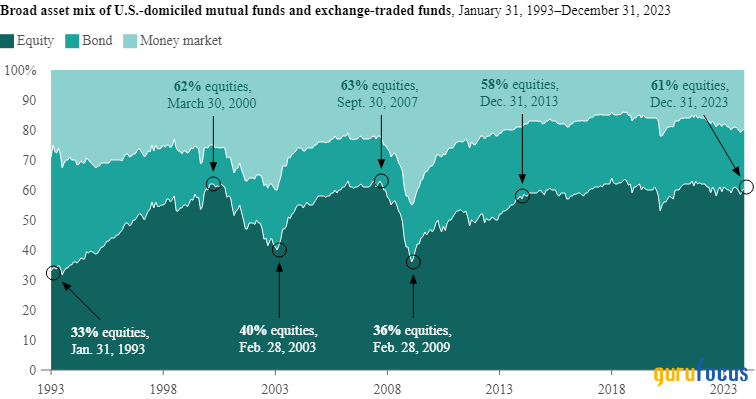Vanguard Market Perspective: Investors Winning as a Behavior Gap Shrinks
We've certainly seen a change in investor behavior, says Michael DiJoseph, CFA, of Vanguard's Investment Advisory Research Center.
What's new, in the last decade, is the relative stability in U.S. investors' allocations to stock, bond, and money market funds. Prior to 2014, those allocations varied widely, with equity stakes peaking just before significant equity drawdowns and bottoming just before strong rallies.
An encouraging sign: Investors' aggregate asset mix has stabilized
Broad asset mix of U.S.-domiciled mutual funds and exchange-traded funds, January 31, 1993December 31, 2023


Notes: The chart reflects the dollar-weighted, month-end allocations of all U.S.-domiciled mutual funds and exchange-traded funds classified as equity or bond or money market by Morningstar. Balanced funds are excluded.
Source: Vanguard Investment Advisory Research Center calculations, based on data from Morningstar, as of December 31, 2023.
Consider that at the end of September 2007 investors held one of their largest equity stakes of the last 30 years, 62.6%. Soon thereafter the global financial crisis (GFC) would reveal itself in the bankruptcies of Lehman Brothers, Washington Mutual, and General Motors. Starting in October 2007, major stock indexes fell by more than half in 17 months.
"But," says DiJoseph, a senior advice strategist, The post-GFC era is the worst example. Investors' aggregate equity stake bottomed at 36% at the start of March 2009, just as an 11-year bull market got under way.
If investors had rebalanced regularly to target asset mixesif they had stayed the course regardless of market conditionstheir pre-2013 allocations to equity, bond, and money market funds would have changed much less dramatically. And investors almost surely would have captured more of the markets' long-term gross returns.
A turning point in investor behavior, worth some $500 billion
DiJoseph points to the relative stability in investors' stakes across the three fund types over the last decade or so as meaningful progress toward better outcomes for investors.
The broad U.S. stock market shed roughly 35% of its value in the span of a month in early 2020, as the Covid-19 pandemic emerged. It declined about 20% in 2022. Neither downturn led to an especially large change in the aggregate equity allocation.
Vanguard and other industry sources have for many years identified various forms of an investor behavior gapsignificant shortfalls in the returns that investors realize relative to the nominal returns provided by their funds or the broad financial markets.1
One way our Investment Advisory Research Center defines the gap is as the return shortfall that tends to accumulate when investors' equity allocations are below their long-term average level. The team estimates that, for the 2000-2012 period, that shortfall averaged 1.55 percentage points annually. Given that tens of trillions of dollars are invested in mutual funds and exchange-traded funds (ETFs), such a shortfall spells hundreds of billions in foregone investor returns.
Indeed, if the 1.55-percentage-point return gap had persisted in the 20132023 period, investors would have accumulated roughly $500 billion less than they did.2 Instead, notably more consistent allocations to equity, bond, and money market funds helped preserve that wealth, DiJoseph says.
Most fund investments reflect advice
The team's hypothesis is that industry-wide changes in the delivery of investment advice and in the investment funds themselves account for the improved results. Those include the widespread shift to fee-based (rather than commission-based) financial advice, the related, surging popularity of ETFs and model portfolios, and the dominance of target-date funds (TDFs) in employer-sponsored retirement plans.
While precise data are not available, our Investment Advisory Research Center estimates that the owners of about 80% of all fund assets receive advice, either directly from an advisor or indirectly through TDFs and the effective design of employer-sponsored retirement plans.
We've been talking about the sources of wealth destruction, including high fund costs, counterproductive investor behavior, and taxes, as part of our Advisor's Alpha framework for 20 years, says DiJoseph. We've also been talking about the ability of financial advisors to help investors keep more of the markets' returns through behavioral coaching. Time will tell if the trend holds, but we believe we're starting to see that potential being realized.
1 Morningstar, for example, has published Mind the Gap, a report examining the differences between time-weighted fund returns and dollar-weighted investor returns, annually since 2005.
2 Source: Vanguard. Data as of December 31, 2023.
Notes:
All investing is subject to risk, including the possible loss of the money you invest. Diversification does not ensure a profit or protect against a loss.
Investments in bonds are subject to interest rate, credit, and inflation risk.
Be aware that fluctuations in the financial markets and other factors may cause declines in the value of your account. There is no guarantee that any particular asset allocation or mix of funds will meet your investment objectives or provide you with a given level of income.
Investments in target-date funds are subject to the risks of their underlying funds. The year in the fund name refers to the approximate year (the target date) when an investor in the fund would retire and leave the workforce. The fund will gradually shift its emphasis from more aggressive investments to more conservative ones based on its target date. An investment in target-date funds is not guaranteed at any time, including on or after the target date.
CFA is a registered trademark owned by CFA Institute.
This article first appeared on GuruFocus.

 Yahoo Finance
Yahoo Finance 